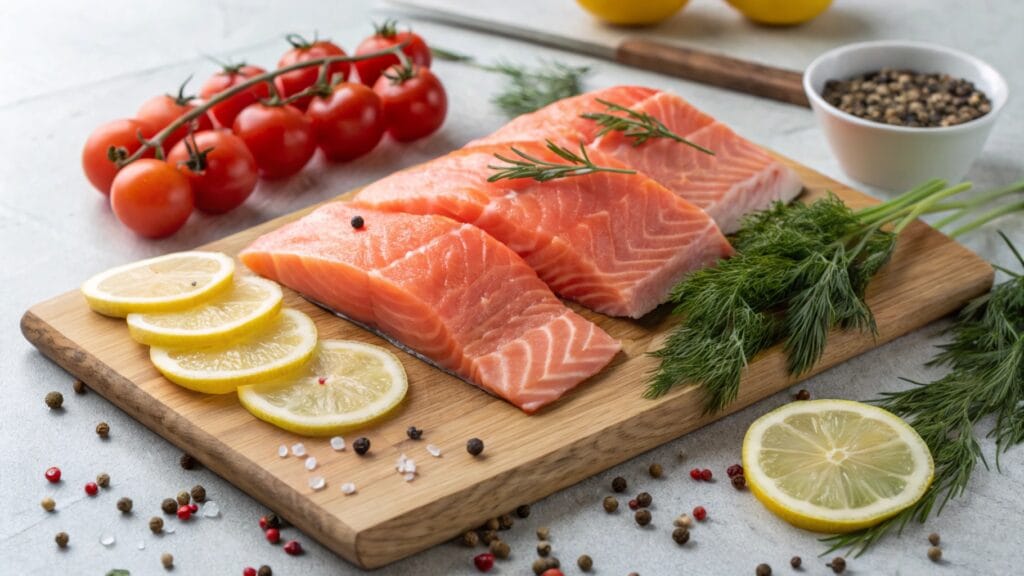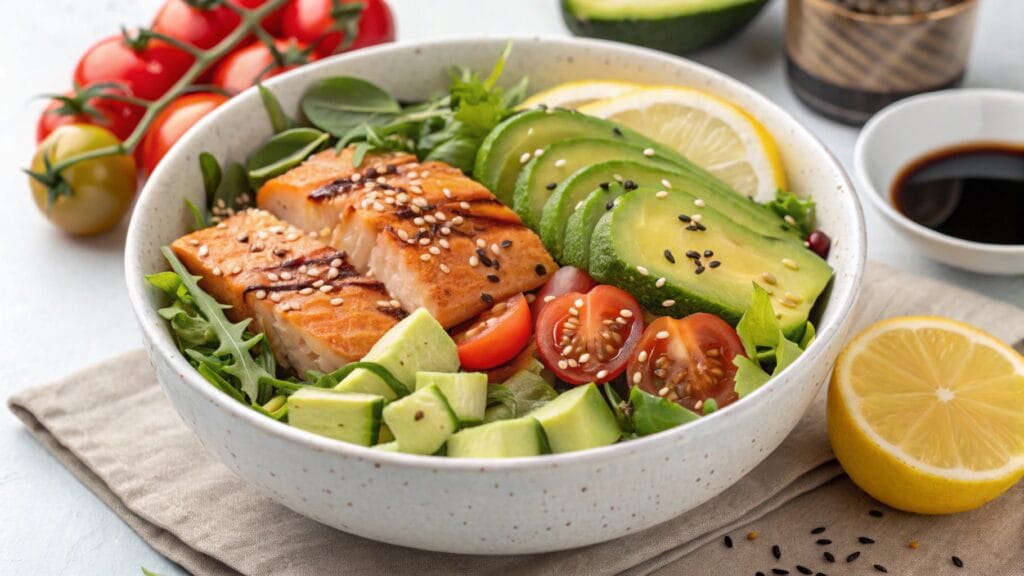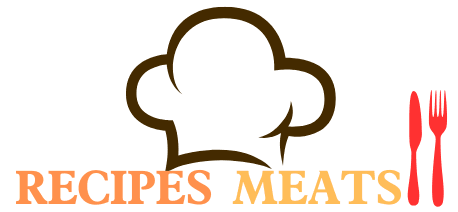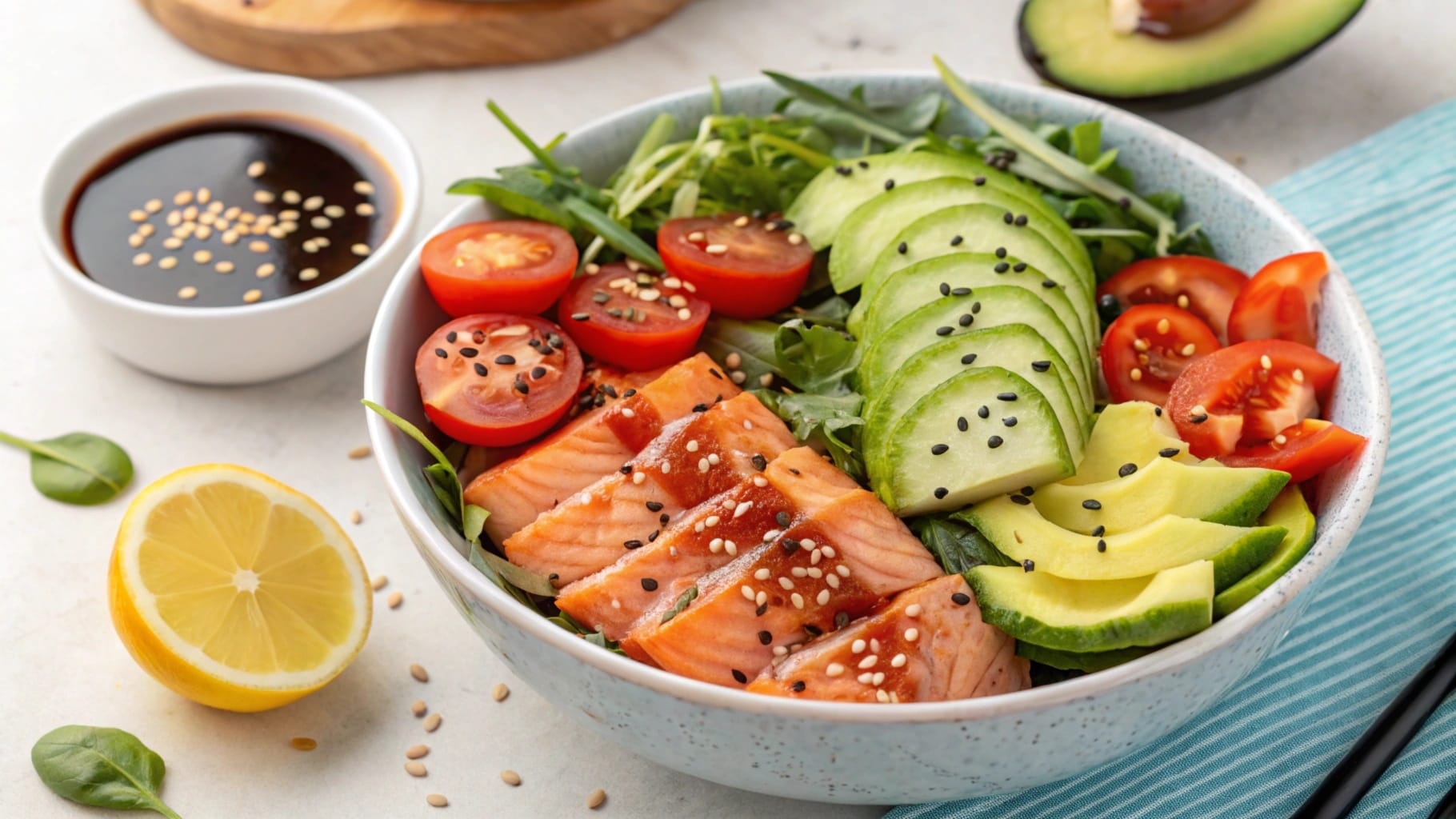When it comes to meals that balance nutrition, flavor, and creativity, salmon bowls hit the trifecta. Packed with omega-3 fatty acids, loaded with vibrant vegetables, and easily customizable, they’re a perfect choice for anyone looking to eat healthy without compromising taste. In this article, we’ll dive deep into the world of salmon bowls, exploring their benefits, recipe ideas, common pitfalls, and how to make them your own.
Why Salmon Bowls Are a Nutritional Powerhouse
Salmon bowls are more than just a trendy Instagram-worthy meal. They offer an incredible combination of taste and health benefits. Imagine a bowl of perfectly cooked salmon resting on a bed of fluffy rice, surrounded by fresh vegetables and drizzled with a tantalizing sauce. Sounds mouthwatering, right? But it’s also a meal that does wonders for your body.
Health Benefits of Including Salmon in Your Diet
Salmon, the star of this dish, is a nutritional heavyweight. Here’s what makes it so good for you:
- Rich in Omega-3 Fatty Acids: These healthy fats are essential for brain function, heart health, and reducing inflammation.
- High-Quality Protein: Salmon provides all the essential amino acids your body needs to build and repair tissues.
- Packed with Vitamins: It’s a great source of vitamin D, B vitamins, and selenium, which boost your immune system and energy levels.
“Adding salmon to your diet regularly can help lower the risk of chronic diseases, keep your skin glowing, and even lift your mood!”
Key Ingredients of a Perfect Salmon Bowl
Creating a well-rounded salmon bowl means combining different textures, flavors, and nutrients. Here’s what you need:
- Base: Rice, quinoa, or leafy greens.
- Protein: Salmon—grilled, baked, or even smoked.
- Vegetables: Fresh options like cucumber, avocado, and edamame add crunch.
- Sauce: Soy sauce, teriyaki glaze, or a creamy sriracha mayo can elevate the flavor.
Popular Variations of Salmon Bowls
Let’s be real—one of the best things about salmon bowls is their versatility. Whether you crave something savory, spicy, or refreshing, there’s a variation for you.
Classic Grilled Salmon Bowl
This version is as straightforward as it gets. Grilled salmon paired with white or brown rice, steamed broccoli, and a light soy sauce drizzle. Simple yet satisfying.
Teriyaki Salmon Bowl with Jasmine Rice
Who doesn’t love teriyaki? This bowl features salmon marinated in a sweet and tangy teriyaki sauce served over jasmine rice, with a side of sautéed bell peppers.
Spicy Sriracha Salmon Bowl
If you enjoy a kick of heat, this is your go-to. A spicy sriracha mayo coats the salmon, with shredded carrots, cucumbers, and sesame seeds on top for extra flavor.
Mediterranean Salmon Bowl with Quinoa
This version swaps rice for quinoa and adds Mediterranean staples like cherry tomatoes, olives, and feta cheese. It’s a zesty twist on the classic.
How to Make a Salmon Bowl at Home
Homemade salmon bowls are easier than you think. Follow this guide to create your very own restaurant-quality meal at home.
Choosing the Right Salmon: Fresh vs. Frozen
Fresh salmon is ideal for flavor, but frozen options are equally nutritious and often more affordable. Look for fillets that are bright in color and free of a strong fishy smell.
Step-by-Step Recipe for a Basic Salmon Bowl
Here’s a simple recipe to get you started:

Ingredients
| Ingredient | Quantity |
|---|---|
| Fresh salmon fillets | 2 fillets (6 oz each) |
| Cooked rice (your choice) | 2 cups |
| Soy sauce | 2 tbsp |
| Sesame oil | 1 tsp |
| Cucumber (sliced) | 1 small |
| Avocado (sliced) | 1 |
| Edamame (shelled) | 1 cup |
| Sesame seeds | 1 tsp |
Instructions
- Prepare the Salmon: Brush the fillets with sesame oil and soy sauce, then bake at 400°F (200°C) for 12–15 minutes.
- Assemble the Base: Divide the rice into two bowls.
- Add Toppings: Arrange cucumber, avocado, and edamame around the salmon.
- Garnish: Sprinkle sesame seeds on top for the final touch.
“Cooking salmon at the right temperature ensures a juicy, flaky texture that makes the bowl irresistible!”
Tips for Cooking Salmon Perfectly Every Time
- Use a non-stick pan or parchment paper to prevent sticking.
- Don’t overcook! Salmon should reach an internal temperature of 145°F (63°C).
- Allow the fish to rest for a few minutes after cooking to seal in the juices.
Common Problems and Solutions in Preparing Salmon Bowls
Even the most experienced cooks face challenges when crafting the perfect salmon bowl. Here are common hiccups and how to overcome them:
Avoiding Overcooked or Dry Salmon
One of the biggest pitfalls is overcooking salmon, leading to a dry and unappetizing texture.
- Solution: Keep an eye on the cooking time and use a meat thermometer. Aim for an internal temperature of 145°F (63°C). If you don’t have a thermometer, check if the salmon flakes easily with a fork—it’s a good sign it’s done!
- Tip: Marinating the salmon before cooking helps retain moisture and enhance flavor.
Making Salmon Bowls on a Budget
Fresh salmon can be pricey, but you don’t have to break the bank to enjoy this dish.
- Solution: Opt for frozen salmon fillets, which are often more affordable and equally nutritious. Canned salmon is another budget-friendly option that works well in bowls.
- Pro Tip: Shop during sales or look for store-brand salmon for extra savings.
Storing and Reheating Leftovers Without Losing Flavor
Storing leftovers can be tricky—reheated salmon often loses its texture.
- Solution: Store cooked salmon in an airtight container in the fridge for up to three days. Reheat it gently in the microwave, covering it with a damp paper towel to retain moisture.
“Treat your salmon leftovers with care, and you can enjoy the same delicious taste the next day!”
Customizing Your Salmon Bowls for Different Diets
The beauty of salmon bowls lies in their adaptability. Whether you’re gluten-free, keto, or vegan, there’s a version for you!
Gluten-Free Salmon Bowl Ideas
Avoiding gluten? No problem.
- Swap soy sauce with gluten-free tamari or coconut aminos.
- Use naturally gluten-free grains like quinoa or rice for the base.
Low-Carb and Keto-Friendly Salmon Bowls
Looking to cut down on carbs? Salmon bowls can still be part of your plan.
- Skip the grains and use a bed of zucchini noodles or cauliflower rice.
- Add high-fat toppings like avocado and a drizzle of olive oil for that keto edge.
Vegan Alternatives to Traditional Salmon Bowls
What if you’re plant-based but love the concept?
- Replace salmon with tofu, tempeh, or even roasted sweet potatoes.
- Use a vegan “fish” sauce or a tangy miso-based dressing to mimic the umami flavors.
“A well-customized salmon bowl isn’t just food; it’s an expression of your dietary journey.” 🌱
Pairing Your Salmon Bowl with the Perfect Sides
The right sides can transform your salmon bowl into a feast. Here’s how to create a balanced and flavorful experience:
Fresh Vegetable Options for Added Crunch
Adding fresh veggies not only boosts nutrition but also creates a satisfying crunch.
- Top Picks: Cucumber slices, shredded carrots, or julienned radishes.
- Why It Works: These veggies bring a light, refreshing contrast to the richness of the salmon.
Complementary Sauces and Dressings
A good sauce ties everything together, and the options are endless.
- Top Picks: Teriyaki glaze, creamy avocado dressing, or tangy lemon-tahini sauce.
- Pro Tip: Don’t be afraid to mix and match—sometimes a simple drizzle of soy sauce with a hint of honey can work wonders.
“A sauce isn’t just a finishing touch; it’s the glue that binds all those delicious components together.”
Where to Find the Best Salmon Bowls Near You
Sometimes, making salmon bowls at home isn’t an option. But don’t worry, many restaurants have perfected the art of this dish.
Top Restaurants Specializing in Salmon Bowls
Keep an eye out for sushi spots, poke bowl eateries, and farm-to-table restaurants—they often offer exceptional salmon bowls.
- Pro Tip: Look for places that emphasize fresh, local ingredients to ensure maximum flavor.
Local and Seasonal Ingredients to Enhance Flavor
Even if you’re dining out, ask about seasonal variations. Ingredients like heirloom tomatoes in summer or roasted squash in winter can elevate your bowl to another level.
“A well-made salmon bowl is more than a meal—it’s a taste of the season!”
Final Thoughts: The Versatility and Appeal of Salmon Bowls
Salmon bowls are truly a marvel in the culinary world. They’re healthy, flavorful, and versatile enough to suit any palate or dietary preference. Whether you’re whipping one up at home, customizing it for your diet, or enjoying it at a trendy restaurant, this dish never fails to impress.
So, the next time you’re looking for a meal that satisfies both your taste buds and your health goals, you know what to choose. After all, who can resist the allure of a beautifully crafted salmon bowl? 🍣

FAQs About Salmon Bowls
How do I ensure my salmon bowl stays fresh for meal prep?
Meal-prepping salmon bowls is a fantastic idea, but maintaining their freshness requires a few tricks. First, store the ingredients separately. For example, keep the salmon, rice, and vegetables in separate containers to avoid sogginess. Use airtight containers and refrigerate them promptly after cooking.
- Pro Tip: Add sauces and dressings right before eating to keep your ingredients crisp and vibrant.
Can I use canned salmon instead of fresh salmon in a salmon bowl?
Absolutely! Canned salmon is a budget-friendly and convenient alternative. It’s already cooked and easy to flake into your bowl. Opt for canned salmon packed in water to reduce added calories and sodium.
- Bonus Tip: Mix the canned salmon with a bit of olive oil, lemon juice, or your favorite spices for added flavor.
What are the best substitutions for rice in salmon bowls?
If you want to skip the rice, there are plenty of delicious alternatives. Quinoa, farro, and couscous work well for a hearty base. For a low-carb option, consider cauliflower rice, zucchini noodles, or even a bed of mixed greens.
- Why it works: These substitutes add variety, texture, and nutrition to your bowl while catering to different dietary preferences.
How can I make my salmon bowl kid-friendly?
Kids might be picky eaters, but salmon bowls can be tailored to suit their tastes! Opt for mild flavors—skip the spicy sauces and instead use honey glaze or a light teriyaki sauce. Include fun, colorful ingredients like shredded carrots, corn, or mango slices.
- Engagement Tip: Let your kids assemble their bowls. Offering them choices makes the meal more interactive and enjoyable.
What’s the best way to reheat a salmon bowl without drying out the salmon?
Reheating salmon requires care to preserve its texture. For best results, use a microwave at 50% power and cover the salmon with a damp paper towel to maintain moisture. Alternatively, reheat it gently in a covered skillet over low heat.
- Pro Tip: If you’re reheating rice along with salmon, add a splash of water to the rice to keep it soft and fluffy.
Best salmon bowl recipe
The best recipe combines fresh salmon, fluffy rice, crunchy veggies, and a drizzle of teriyaki sauce for a perfect balance of flavors.
Easy salmon bowl recipes
Try a quick mix of baked salmon, pre-cooked rice, sliced avocado, and a simple soy-mayo dressing for an effortless meal.
15-minute salmon bowl recipe
Pan-sear salmon fillets, toss them over microwave rice, and top with fresh veggies and sesame seeds—it’s fast and delicious!
Salmon bowl recipe
A classic salmon bowl includes rice, grilled salmon, edamame, cucumbers, and a zesty ginger-soy sauce.
Quel saumon pour poke bowl
Optez pour du saumon frais, de qualité sashimi, pour un poke bowl savoureux et sûr à consommer cru.

